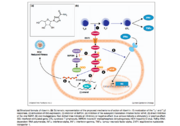Ribavirin
From Proteopedia
(Difference between revisions)
| Line 16: | Line 16: | ||
== Mechanism == | == Mechanism == | ||
| + | Ribavirin, when administered in combination with pegylated interferon alpha, induces an antiviral state in host cells, resulting in reduced virus replication rates and activation of the host immune system. It is thought that Ribavirin acts as an antiviral agent by disrupting viral RNA synthesis, which would impact both transcription and genome replication in the Hepatitis C virus. However, the exact mechanism by which the drug interferes with this process is unknown. Several theories have been proposed to explain the effect of Ribavirin in inhibiting the replication of the Hepatitis C virus (Paeshuyse et al). | ||
| + | |||
| + | Immunomodulation by Ribavirin may be responsible for the drug’s antiviral properties. It has been suggested that the natural CD4+ helper T cell response may be altered in the presence of Ribavirin. It is thought that ribavirin may enhance the T helper 1 response, resulting in greater clearance of virus (Hofmann et al). However, there is conflicting evidence suggesting that the T helper 2 response may be implicated in this process instead (Fujimoto et al). Another possible mechanism involves the enhancement of interferon-stimulated gene (ISG) expression by Ribavirin. When a cell becomes infected with a virus, it may release interferons. Interferons are signaling molecules that function in a paracrine fashion to induce an antiviral state in neighboring cells, protecting them from infection. Ribavirin is thought to enhance the interferon signaling pathway (Feld et al), resulting in a wider antiviral response. This theory has been supported in studies using cell culture models (Thomas et al). It has also been suggested that the relationship between Ribavirin and inosine 5’-monophosphate dehydrogenase (IMPDH) may impact this process. IMPDH play a significant role in the guanine nucleotide synthesis pathway. It results in the conversion of inosine 5’-monophosphate to xanthine 5’-monophosphate, which is an intermediate for the nucleotide guanosine (Shu et al). Therefore, modulation of IMPDH activity affects a cell’s reservoir of guanosine. Ribavirin has been shown to function as a competitive inhibitor for IMPDH (Streeter et al). Because guanosine triphosphate (GTP) plays a critical role in the viral genome replication process, inhibition of IMPDH would result in the prevention of viral replication. | ||
| + | |||
| + | Ribavirin has also been shown to act as an inhibitor for eIF4E, a protein of the translation initiation complex (Kentsis et al). Because of its structural similarity to guanosine, it mimics the 7-methyl guanosine mRNA cap, preventing translation. This would result in reduced capacity for viral replication within an infected cell. The Hepatitis C viral genome is replicated by RNA-dependent RNA polymerase (RdRp). A modified form of Ribavirin, Ribavirin 5’-triphosphate (RTP) is also believed to directly inhibit RdRp activity (Graci et al), resulting in lower rates of genome replication. If Ribavirin is converted to the monophosphate form, RMP, it is believed to be incorporated into the viral genome, functioning as a mutagen. | ||
| + | |||
| - | This is a sample scene created with SAT to <scene name="/12/3456/Sample/1">color</scene> by Group, and another to make <scene name="/12/3456/Sample/2">a transparent representation</scene> of the protein. You can make your own scenes on SAT starting from scratch or loading and editing one of these sample scenes. | ||
[[Image:Mechanisms.png | thumb]] | [[Image:Mechanisms.png | thumb]] | ||
Revision as of 04:13, 16 November 2016
1-β-D-ribofuranosyl-1H-1,2,4-triazole-3-carboxamide [1]
| |||||||||||
References
- Gish, R. G. Treating HCV with ribavirin analogue and ribavirin-like molecules. Journal of Antimicrobial Chemotherapy. 2005, November 17;1-6. doi:10.1093/jac/dki405
- Chung, R.T., Gale, M.J., Polyak, S.J., Lemon, S.M., Liang, T.J., & Hoofnagle, J.H. Mechanisms of action of interferon and ribavirin in chronic hepatitis C: Summary of a workshop. Hepatology. 2008;47 (1), 306-320. doi: 10.1002/hep.22070
- Paeshuyse, J, Dallmeier, K, Neyts, J. Ribavirin for the treatment of chronic hepatitis C virus infection: a review of the proposed mechanisms of action. Current Opinion in Virology. 2011;1(6) 590-598. doi: 10.1016/j.coviro.2011.10.030
- National Heart, Lung and Blood Institute. Pneumonia. 2016, September 26; Retrieved from https://www.nhlbi.nih.gov/health/health-topics/topics/pnu
- Foster, G. Pegylated interferons for the treatment of chronic Hepatitis C. Drugs. 2010;70(2):147-165. doi:10.2165/11531990-000000000-00000
- Hofmann WP, Herrmann E, Sarrazin C, Zeuzem S. Ribavirin mode of action in chronic hepatitis C: from clinical use back to molecular mechanisms. Liver Int. 2008, 28:1332-1343. doi: 10.1111/j.1478-3231.2008.01896.x
- Fujimoto T, Tomimatsu M, Iga D, Endo H, Otsuka K. Changes in the Th1/Th2 ratio during a 24-week course of an interferon alpha-2b plus ribavirin combination therapy for patients with chronic hepatitis C. J. Gastroenterol. Hepatol. 2008, 23:E432- E437. doi: 10.1111/j.1440-1746.2008.05320.x
- Feld, JJ, Nanda, S, Huang, Y, Chen, W, Cam, M, Pusek, SN, Schwigler, LM, Theodore, D, Zacks, SL, Liang, TJ, Fried, MW. Hepatic gene expression during treatment with peginterferon and ribavirin: Identifying molecule pathways for treatment response. Hepatol. 2007, 46(5): 1548-1563. doi: 10.1002/hep.21853
- Thomas E, Feld JJ, Li QS, Hu ZY, Fried MW, Liang TJ. Ribavirin potentiates interferon action by augmenting interferon stimulated gene induction in hepatitis C virus cell culture models. Hepatology 2011, 53:32-41. doi: 10.1002/hep.23985
- Shu QN, Nair V. Inosine monophosphate dehydrogenase (IMPDH) as a target in drug discovery. Med. Res. Rev. 2008, 28:219-232. doi: 10.1002/chin.200823265
- Streeter, DG, Witkowski, JT, Khare, GP, Sidwell, RW, Bauer, RJ, Robins, RK, Simon, LN. Mechanisms of action of 1-β-D-ribofuranosyl-1,2,4-triazole-3-carboxamide (virazole) a new broad spectrum antiviral agent. Proc. Natl. Acad. Sci. 1973, 70:1174-1178. PMID: 4197928
- Kentsis, A, Topisirovic, I, Culjkovic, B, Shao, L, Borden, KLB. Ribavirin suppresses eIF4E-mediated oncogenic transformation by physical mimicry of the guanosine mRNA cap. Proc. Natl. Acad. Sci. 2004, 101:18105-18110. Doi: 10.1073/pnas.0406927102
- Graci, JD, Cameron, CE. Mechanisms of action of ribavirin against distinct viruses. Rev. Med. Virol. 2006, 16: 37-48. Doi: 10.1002/rmv.483
Proteopedia Page Contributors and Editors (what is this?)
Jamie Costa, Edmond R Atalla, Katherine Reynolds, Taylor H. Derby, Shannon Shaughnessy, Alexander Berchansky

